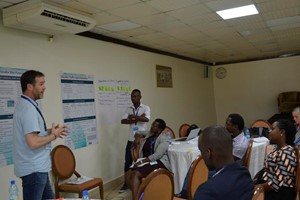CGIAR’s Sustainable Animal Productivity and Livelihoods, Nutrition and Gender inclusion Initiative (SAPLING) has developed a tool for assessing, identifying and responding to food and nutrition security problems in developing countries.
The Food Security, Environments and Nutrition: Structured Evidence (FoodSENSE), is a decision support process developed by SAPLING researchers to aid decision makers in identifying barriers to improved food security and nutrition, and then to structure dialogue for prioritization of appropriate solutions for target demographic groups. The tool provides site-specific information on foods consumed, where they are sourced and the nutritional outcomes. It is also used to evaluate food systems and environments, including markets, value chains and socio-cultural norms and their effects on household nutrition.
Working under SAPLING, researchers from the International Livestock Research Institute (ILRI) piloted the tool at the beginning of 2023 to identify food and nutrition challenges in the Central Uganda districts of Mukono, Masaka and Mpigi, which are some of the SAPLING project sites in Uganda. As part of the tool’s validation, representatives from national and local governments, academia, the United Nations, research institutions, civil society and industry met for a two-day workshop in April 2023 in Kampala. They assessed the nutritional status of residents in the three districts, reviewed the survey results and kick-started dialogue on potential solutions to the key challenges identified.
This research is part of SAPLING’s work package 2 that focuses on promoting consumption of livestock-derived foods as part of diverse diets. A social behavior changes communication (SBCC) intervention aimed at influencing behavior around diets and food safety practices will be developed as part of this work.
Malnutrition is rampant in Uganda. Data are scarce and not up to date, but available data shows that among children younger than five years, 53% suffer from anaemia, 29% from stunting and 11% are underweight. Among women of reproductive age, 32% have anaemia and 9% are underweight while 24% are overweight or obese. Malnutrition is especially widespread in areas where commercial farming of crops like sugarcane and tea is practiced because family land is allocated to these crops and little, if any, is left for growing food crops. Additionally, increased household preference for market production reduces production for own consumption even when households have the capacity. Seemingly, the income derived from the commercial crops is not used to purchase nutritious foods, likely due to limited knowledge on nutrition. This situation is worsened by soil exhaustion and climate change, which make agriculture increasingly unpredictable and expensive.
Despite these challenges, the nutrition sector in Uganda is plagued by underfunding, evidenced by the limited number of personnel at all levels, as well as low capacities and inadequate equipment at health facilities to screen and manage malnutrition. There is limited dialogue and cross-sectoral engagement between key government ministries, departments and agencies such as the the Ministry of Health, Ministry of Agriculture, Animal Industries and Fisheries; the Ministry of Finance, Planning and Economic Development and local governments. In most cases, nutrition is seen as a mandate of the Ministry of Health and its sister agencies. How to facilitate the much needed multisectoral approach remains a challenge.
We can now identify challenges to food and nutrition security across the food system and, working with stakeholders, tailor solutions to specific locations depending on severity of the challenges, available structures and resources,’ said Jim Hammond, a senior scientist at ILRI.
Hammond, who was part of the team that developed the tool said it will soon be made available to stakeholders to use in nutrition evaluations.
Ongoing interventions to tackle malnutrition in the three districts and other parts of the country include provision of a SBCC package by the Ministry of Health that focuses on pregnant and lactating women and mothers of children under the age of five by providing them with information through care groups, school feeding programs, school kitchen gardens and linking pregnant mothers to health facilities to access iron supplements. However, most of these interventions are implemented with support from civil society organizations and development partners, which may limit their continuity and sustainability once the projects end. To address this, stakeholders called for proper data collection and integration of nutrition interventions in ongoing government programs.










